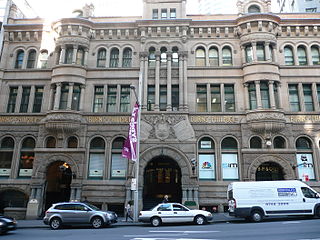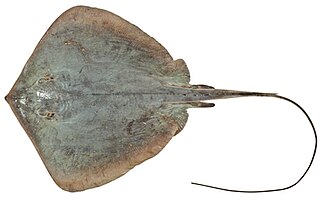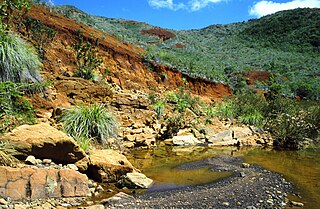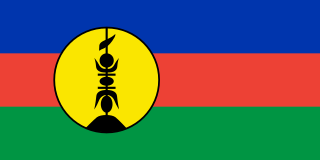
New Caledonia is a sui generis collectivity of overseas France in the southwest Pacific Ocean, south of Vanuatu, about 1,210 km (750 mi) east of Australia, and 17,000 km (11,000 mi) from Metropolitan France. The archipelago, part of the Melanesia subregion, includes the main island of Grande Terre, the Loyalty Islands, the Chesterfield Islands, the Belep archipelago, the Isle of Pines, and a few remote islets. The Chesterfield Islands are in the Coral Sea. French people, especially locals, call Grande Terre "Le Caillou". New Caledonia is one of the European Union's Overseas Countries and Territories (OCTs), but is not part of the European Union.

The geography of New Caledonia (Nouvelle-Calédonie), an overseas collectivity of France located in the subregion of Melanesia, makes the continental island group unique in the southwest Pacific. Among other things, the island chain has played a role in preserving unique biological lineages from the Mesozoic. It served as a waystation in the expansion of the predecessors of the Polynesians, the Lapita culture. Under the Free French it was a vital naval base for Allied Forces during the War in the Pacific.

New Caledonia is a major source for nickel and contains roughly 10% of the world's known nickel supply. The islands contain about 7,100,000 tonnes of nickel. With the annual production of about 107,000 tonnes in 2009, New Caledonia was the world's fifth largest producer after Russia (266,000), Indonesia (189,000), Canada (181,000) and Australia (167,000). In recent years, the economy has suffered because of depressed international demand for nickel due to the 2007-2008 global financial crisis. Only a negligible amount of the land is suitable for cultivation, and food accounts for about 20% of imports. In addition to nickel, the substantial financial support from France and tourism are keys to the health of the economy. In the 2000s, large additions were made to nickel mining capacity. The Goro Nickel Plant is expected to be one of the largest nickel producing plants on Earth. This plant produces an estimated 20% of the global nickel supply. However, the need to respond to environmental concerns over the country's globally recognized ecological heritage, may increasingly need to be factored into capitalization of mining operations.

Tourism is travel for pleasure, and the commercial activity of providing and supporting such travel. UN Tourism defines tourism more generally, in terms which go "beyond the common perception of tourism as being limited to holiday activity only", as people "travelling to and staying in places outside their usual environment for not more than one consecutive year for leisure and not less than 24 hours, business and other purposes". Tourism can be domestic or international, and international tourism has both incoming and outgoing implications on a country's balance of payments.

Ecotourism is a form of tourism marketed as "responsible" travel to natural areas, conserving the environment, and improving the well-being of the local people. The stated purpose may be to educate the traveler, to provide funds for ecological conservation, to directly benefit the economic development and political empowerment of local communities, or to foster respect for different cultures and human rights.

Saugatuck is a city in Allegan County in the U.S. state of Michigan. The population was 865 at the 2020 census. The city is within Saugatuck Township, but is administratively autonomous.

The Pacific Community (PC), formerly the South Pacific Commission (SPC), is an international development organisation governed by 27 members, including 22 Pacific island countries and territories around the Pacific Ocean. The organisation's headquarters are in Nouméa, New Caledonia, and it has regional offices in Suva, Pohnpei, and Port Vila, as well as field staff in other locations in the Pacific. Its working languages are English and French. It primarily provides technical and scientific advice, and acts as a conduit for funding of development projects from donor nations. Unlike the slightly smaller Pacific Islands Forum, the SPC is not a trade bloc, and does not deal with military or security issues.

The CFP franc is the currency used in the French overseas collectivities of French Polynesia, New Caledonia, and Wallis and Futuna. The initials CFP originally stood for colonies françaises du Pacifique but since 2022 is officially Collectivités françaises du Pacifique. Its ISO 4217 currency code is XPF. The CFP franc is subdivided into 100 centimes, although there are no centime denominations. The currency is issued by Institut d'émission d'outre-mer (IEOM).

Araucaria is a genus of evergreen coniferous trees in the family Araucariaceae. While today they are largely confined to the Southern Hemisphere, during the Jurassic and Cretaceous they were distributed globally. There are 20 extant species in New Caledonia, Norfolk Island, eastern Australia, New Guinea, Argentina, Brazil, Chile and Uruguay.

Nouméa is the capital and largest city of the French special collectivity of New Caledonia and is also the largest francophone city in Oceania. It is situated on a peninsula in the south of New Caledonia's main island, Grande Terre, and is home to the majority of the island's European, Polynesian, Indonesian, and Vietnamese populations, as well as many Melanesians, Ni-Vanuatu and Kanaks who work in one of the South Pacific's most industrialised cities. The city lies on a protected deepwater harbour that serves as the chief port for New Caledonia.

Burnt Pine is the largest town on Norfolk Island, an Australian external territory located in the Pacific Ocean between New Caledonia and New Zealand. It is the main commercial hub of the island, and travel from one side of the island to another generally involves passing through Burnt Pine as the island's sole thoroughfare runs through the town's centre.
Tourism in Papua New Guinea is a fledgling industry but there are attractions for the potential visitor which include culture, markets, festivals, diving, surfing, hiking, fishing and the unique flora and fauna. Papua New Guinea receives an increasing number of visitors each year, with approximately 184,000 international arrivals in 2015.

Dark tourism has been defined as tourism involving travel to places historically associated with death and tragedy. More recently, it was suggested that the concept should also include reasons tourists visit that site, since the site's attributes alone may not make a visitor a "dark tourist". The main attraction to dark locations is their historical value rather than their associations with death and suffering. Holocaust tourism contains aspects of both dark tourism and heritage tourism.

Burns Philp was a major Australian shipping line and merchant that operated in the South Pacific. When the well-populated islands around New Guinea were targeted for blackbirding in the 1880s, a new rush for labour from these islands began. James Burns and Robert Philp purchased several well-known blackbirding ships to quickly exploit the human resource in this region, and Burns Philp entered the slave trade. The company ended its involvement in blackbirding in 1886. In later years the company was a major player in the food manufacturing business. Since its delisting from the Australian Securities Exchange in December 2006 and the subsequent sale of its assets, the company has mainly become a cashed up shell company. It is wholly owned by Graeme Hart's Rank Group.

Sustainable tourism is a concept that covers the complete tourism experience, including concern for economic, social, and environmental issues as well as attention to improving tourists' experiences and addressing the needs of host communities. Sustainable tourism should embrace concerns for environmental protection, social equity, and the quality of life, cultural diversity, and a dynamic, viable economy delivering jobs and prosperity for all. It has its roots in sustainable development and there can be some confusion as to what "sustainable tourism" means. There is now broad consensus that tourism should be sustainable. In fact, all forms of tourism have the potential to be sustainable if planned, developed and managed properly. Tourist development organizations are promoting sustainable tourism practices in order to mitigate negative effects caused by the growing impact of tourism, for example its environmental impacts.

The estuary stingray, also called the estuary stingaree or brown stingray, is a species of stingray in the family Dasyatidae. Endemic to eastern Australia, it typically inhabits shallow, mangrove-lined tidal rivers, estuaries, and bays in southern Queensland and New South Wales. This yellow-brown to olive ray grows to at least 93 cm (37 in) across. It has a diamond-shaped pectoral fin disc and a mostly smooth, whip-like tail bearing both dorsal and ventral fin folds. It can additionally be identified by its long, narrow nostrils and the row of thorns along the midline of its back.
Japanese settlement in New Caledonia dates back to the 19th century when male indentured labourers were brought to the island and worked in the nickel mines. Some of whom settled down in New Caledonia, and often intermarried with women of other ethnicities. After the Second World War, most of the island's Japanese were repatriated back to Japan, although a small minority remained behind.

Nickel mining in New Caledonia is a major sector of the New Caledonian economy. The island contains about 7.1 million tonnes of nickel reserves, about 10% of the world's total. With an annual production of 200,000 tonnes in 2020, New Caledonia was the world's fourth largest producer after Indonesia (760,000), Philippines (320,000), and Russia (280,000), followed by Australia (170,000) and Canada (150,000).

The Kanaks are the indigenous Melanesian inhabitants of New Caledonia, an overseas collectivity of France in the southwest Pacific. Kanak peoples traditionally speak diverse Austronesian languages, that belong to the New Caledonian branch of Oceanic. According to the 2019 census, the Kanaks make up 41.2% of New Caledonia's total population — corresponding to around 112,000 people.

Naval Base Noumea was a major United States Navy sea and air base at Nouméa, New Caledonia. Naval Base Noumea was built at Noumea Harbor. Noumea was picked for a Naval Base as it was beyond the range of Japanese land-based planes. Noumea is on the east side the Coral Sea, 1,469 kilometres from Brisbane, Australia. The base was built during World War II to support the many ships and aircraft fighting and patrolling in the South West Pacific theatre of war as part of the Pacific War. Naval Base Noumea had anchorage for large ships. Noumea was protected against submarine attack by a ring of islands and Naval minefields. At its peak 50,000 troops were stationed at Naval Base Noumea. New Caledonia has been a colony of France since 1853. Noumea is the capital City of New Caledonia on the southwest end of the island. On November 8, 1942, US Navy South Pacific headquarters moved to Noumea.


















